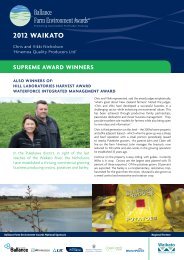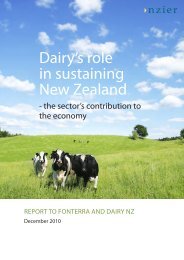NZIER report on compensation for transmission infrastructure
NZIER report on compensation for transmission infrastructure
NZIER report on compensation for transmission infrastructure
You also want an ePaper? Increase the reach of your titles
YUMPU automatically turns print PDFs into web optimized ePapers that Google loves.
clear. Compensati<strong>on</strong> was not awarded <strong>for</strong> externalities in a smaller number of cases,<br />
such as in Québec (Hydro-Québec 2000).<br />
Some authors argue that compensati<strong>on</strong> should be awarded to people who have had<br />
their views upset by transmissi<strong>on</strong> lines, regardless of whether or not they own the<br />
land that the lines run over (Beesley 2008). In Finland compensati<strong>on</strong> <strong>for</strong> disturbance<br />
to view extended to people who suffered due to transmissi<strong>on</strong> <strong>infrastructure</strong> running<br />
across neighbouring property (Nuuja and Viitanen 2007). With the excepti<strong>on</strong> of<br />
Finland, however, we found no evidence of any<strong>on</strong>e being compensated, other than<br />
the landowner who had towers and lines across their land. In New Zealand such<br />
effects <strong>on</strong> third parties are dealt with through the Resource Management Act and are<br />
not part of easement agreements between utilities and landowners.<br />
A number of researchers have c<strong>on</strong>sidered how power lines impact <strong>on</strong> land sales<br />
values (see, <strong>for</strong> example, Colwell 1990). Some studies c<strong>on</strong>clude that power lines do<br />
reduce neighbouring land sale prices while others suggest there is little relati<strong>on</strong>ship.<br />
When there is an effect <strong>on</strong> property value it tends to decrease rapidly with distance<br />
from the transmissi<strong>on</strong> <strong>infrastructure</strong>. Properties immediately adjacent to land with<br />
wires bear the brunt of any price effect.<br />
Although robust evidence linking adverse health effects with EMFs is lacking, it has<br />
been argued (and stated by the Finnish Supreme Court – see Nuuja and Viitanen<br />
2007) that the perceived health risk is enough to lower land values and hence should<br />
be compensated <strong>for</strong> (see also, Bolt<strong>on</strong> and Sick 1999). In theory, by allowing <strong>for</strong> how<br />
easements change the value of land, compensati<strong>on</strong> in New Zealand allows <strong>for</strong><br />
externalities <strong>for</strong> directly affected landowners.<br />
3.5 Damages<br />
The damages element of compensati<strong>on</strong> is relatively straight<strong>for</strong>ward. In all of the<br />
countries we looked into compensati<strong>on</strong> was provided to cover all of the damage d<strong>on</strong>e<br />
during c<strong>on</strong>structi<strong>on</strong> of the <strong>infrastructure</strong> (see, <strong>for</strong> example, Hydro-Québec 2000). It<br />
was the resp<strong>on</strong>sibility of the utility to either replace or provide financial compensati<strong>on</strong><br />
<strong>for</strong> the likes of damaged crops and broken fences or other equipment.<br />
The payment of damages in New Zealand appears to be of little c<strong>on</strong>cern to affected<br />
landowners or Transpower. The landowners we spoke with were largely satisfied with<br />
Transpower‟s ef<strong>for</strong>ts to replace damaged property or provide financial compensati<strong>on</strong>.<br />
3.6 Payment methods<br />
Easement compensati<strong>on</strong> was provided as a <strong>on</strong>e-off lump-sum capital payment, in<br />
annual payments or as a combinati<strong>on</strong> of lump-sum and annual payments. In Canada<br />
(Alberta and Québec) and the United Kingdom landowners had the opti<strong>on</strong> of<br />
choosing lump-sum or annual or a combinati<strong>on</strong> of the two types of payment (Atlanta<br />
SRB 2009; Hydro-Québec 2000; NFU 2009). Wisc<strong>on</strong>sin law requires that <strong>for</strong> 100kV<br />
or larger lines, <strong>on</strong>e or more miles l<strong>on</strong>g, compensati<strong>on</strong> <strong>for</strong> agriculture land is both<br />
<str<strong>on</strong>g>NZIER</str<strong>on</strong>g> – Compensati<strong>on</strong> <strong>for</strong> transmissi<strong>on</strong> <strong>infrastructure</strong> 23
















